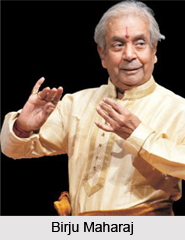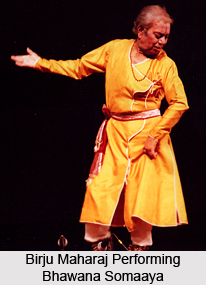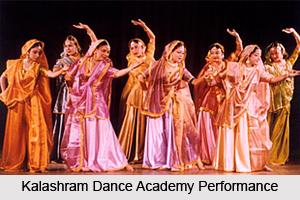 According to renowned musician Ravi Shankar, Birju Maharaj inherited from his father, uncles and few more `greats` of his earlier generations, a loving approach towards the great art form of Kathak. He will remain a historical person in the world of Kathak as Mrs. Sumtra Charat Ram asserts. Pandit Birju Mahara, anj internationally renowned Kathak dancer and a great guru has imparted his immense knowledge and produced several renowned artists. Apart from dancing, he has shown his talents as a superb musician, percussionist, composer, teacher, director, choreographer and a poet. He has a special flair for playing percussion instruments like Tabla, Pakhawaj, Dholak, Naal and string instruments like Israj, Violin, Swar-Mandal, Sitar etc. He has performed in thousands of concerts in India and abroad. He has extensively toured all over the world, i.e. USSR, USA, Japan, UAE, UK, France, Germany, Italy, Aaustria, Czechoslovakia, Burma, Ceylon etc. for performances as well as lecture-demonstrations.
According to renowned musician Ravi Shankar, Birju Maharaj inherited from his father, uncles and few more `greats` of his earlier generations, a loving approach towards the great art form of Kathak. He will remain a historical person in the world of Kathak as Mrs. Sumtra Charat Ram asserts. Pandit Birju Mahara, anj internationally renowned Kathak dancer and a great guru has imparted his immense knowledge and produced several renowned artists. Apart from dancing, he has shown his talents as a superb musician, percussionist, composer, teacher, director, choreographer and a poet. He has a special flair for playing percussion instruments like Tabla, Pakhawaj, Dholak, Naal and string instruments like Israj, Violin, Swar-Mandal, Sitar etc. He has performed in thousands of concerts in India and abroad. He has extensively toured all over the world, i.e. USSR, USA, Japan, UAE, UK, France, Germany, Italy, Aaustria, Czechoslovakia, Burma, Ceylon etc. for performances as well as lecture-demonstrations.
 Early life of Pandit Birju Maharaj
Early life of Pandit Birju Maharaj
The leading exponent of the Lucknow Kalka Bindadin gharana of Kathak dance in India, Pandit Birju Maharaj was born on 4th February 1938. He was a descendant of the legendary Maharaj family of Kathak dancers and was named as Brijmohan Nath Mishra. Renowned Acchan Maharaj was his father as well as guru and Shambhu Maharaj and Lachhu Maharaj were his uncles. He has five children three daughter and two sons.
At the very tender age of seven he performed his first recital and since then there was no looking back. He taught at the Bharatiya Kala Kendra in Delhi, and at the Kathak Kendra a unit of the Sangeet Natak Akademi where he was Head of Faculty, and Director, retiring in 1998.
Besides being a superb dancer, he was also gifted with a number of other qualities, which add to his artistic career. He is a wonderful singer having command over, Thumri, Dadra, Bhajan and Ghazals. He is also superb drummer, with ease and precision playing nearly all drums. With the experimentation of this superb quality in the dance dramas, he has given a new dimension to Kathak. It became successful medium for mass dispersion. His bold and intellectual compositions in traditional themes are brilliant, whereas his contemporary works are also refreshing in concept, crisp and entertaining.

Career of Pandit Birju Maharaj
As a choreographer he is the finest in the country. He composed many dance dramas like `Gobardhan Leela`, `Makhan Chori`, `Malti-Madhav`, `Kumar Samvav`, `Phag Bahar` etc. He also composed two classical dance sequences for Satyajit Ray`s film `Shatranj Ke Khiladi`. Birju Maharaj has also choreographed in films like `Devdas` in 2002, `Gadar` in 2001 and `Dil to Pagal Hai` in 1997.
Recognitions of Pandit Birju Maharaj
Birju Maharaj has bagged several honours and awards like the prestigious national award for the central `Sangeet Natak Academy`, the Indian Government`s highest civilian award `Padma Vibhushan` in 1986, `Kalidas Samman` by the Madhya Pradesh Government, `Soviet Land Nehru Award`, `SNA Award`, `Sangam Kala Award` etc. He was also the recipient of two honorary doctorate degrees from the Benaras Hindu University and the Khairagarh and the `Nehru Fellowship`. He was also the recipient of the Lata Mangeshkar Purashkar in 2002. His talent, dedication, innovation, training, repertoire and performances have earned him the status of a living legend in India.
Death of Pandit Birju Maharaj
Maharaj died due to a cardiac arrest on 17 January 2022 at the age of 83 in Delhi at his residence. He was suffered from a kidney ailment and was undergoing dialysis one month prior to his death.



















